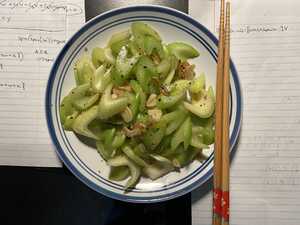
I honestly cannot identify like half of the Chinese vegetables that I cook. I just cook most of them the same way: stir fry with ginger and garlic. Some of them are shown below, although it tends to get repetitive after a while.
In fact, I once came across a vegetable at Panda Supermarket (a local Chinese grocery store in Squirrel Hill) that was literally labeled as a “green leaf,” shown in the following picture.

I’ve noticed that pea tips are some of the priciest green vegetables at Panda. I have tried them a few times, and I can see why: they actually taste pretty good and have an excellent texture. Yam tips are also okay, but the part at the bottom can be tough to chew sometimes.


On the other hand, napa cabbage is one of the cheapest Chinese vegetables you can buy. It’s also easy to prepare, tasty, and filling, so it’s the perfect vegetable for college students. As a side note, the Australians have a much cooler name for it; they apparently call it the “wombok.”


Some more vegetables found in Chinese cooking include bitter melon (苦瓜), cucumber (黄瓜), and various forms of bok choy (most frequently 上海青 in the US). For some reason, my 苦瓜 was much more bitter than when my mom makes it. Maybe I’m just bad at selecting them, or maybe there’s a special way you have to cook them?



A dish that I enjoy a lot at restaurants is 干煸四季豆 (gān biān sìjì dòu), but it’s a lot of effort to make at home. Here’s a similar dish made at home:



This is not the most impressive dish, but one of the first things that I cooked for myself when I was just starting out was sautéed celery, mostly for its simplicity. I still cook it a lot as a sort of weeknight meal. It’s also a very nostalgic food for me, since my mom makes it at home.

I also once made some 丝瓜 (sī guā), which is actually one of my favorite vegetables, after I spotted some at Lotus. But this turned out kind of poorly, so I haven’t included it on this page. My mom later told me that there’s a more “proper” way to cut them, so that you get the pretty triangular-ish cuts. Fun story: we once grew these in our vegetable garden when I was growing up!
One vegetable that I always hated growing up but ended up loving as an adult (wow, I’m technically an adult!) is 茄子 (qié zi, or eggplant). The basic method is to first cook the eggplant until you get a nice sear. According to my mom, as a shortcut you can first soften them in the microwave, but I have not tried this myself. You then take the eggplant out, cook the meat and various spices/aromatics, and then put the eggplant back in and stir-fry to combine.


